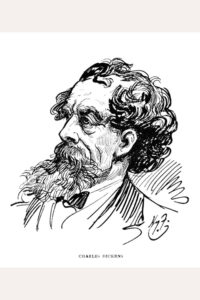
Little Dorrit
Thirty years ago, Marseilles lay burning in the sun, one day.
A blazing sun upon a fierce August day was no greater rarity in southern France then than at any other time, before or since. Everything in Marseilles, and about Marseilles, had stared at the fervid sky, and been stared at in return until a staring habit had become universal there. Strangers were stared out of countenance by staring at white houses, white walls, white streets, tracts of arid road, staring hills from which verdure was burnt away. The only things to be seen not fixedly staring and glaring were the vines drooping under their load of grapes. These did occasionally wink a little, as the hot air barely moved their faint leaves.
There was no wind to make a ripple on the foul water within the harbour, or on the beautiful sea without. The line of demarcation between the two colours, black and blue, showed the point which the pure sea would not pass; but it lay as quiet as the abominable pool, with which it never mixed. Boats without awnings were too hot to touch; ships blistered at their moorings; the stones of the quays had not cooled, night or day, for months. Hindoos, Russians, Chinese, Spaniards, Portuguese, Englishmen, Frenchmen, Genoese, Neapolitans, Venetians, Greeks, Turks, descendants from all the builders of Babel, come to trade at Marseilles, sought the shade alike—taking refuge in any hiding place from a sea too intensely blue to be looked at, and a sky of purple, set with one great flaming jewel of fire.
The universal stare made the eyes ache. Towards the distant line of the Italian coast, indeed, it was a little relieved by light clouds of mist, slowly rising from the evaporation of the sea, but it softened nowhere else. Far away the staring roads, deep in dust, stared from the hillside, stared from the hollow, stared from the interminable plain. Far away the dusty vines overhanging wayside cottages, and the monotonous wayside avenues of parched trees without shade, drooped beneath the stare of earth and sky. So did the horses with drowsy bells, in long files of carts, creeping slowly towards the interior…
Read or download Book
Charles Dickens
Charles John Huffam Dickens (7 February 1812 – 9 June 1870) was an English novelist and social critic who created some of the world’s best-known fictional characters and is regarded by many as the greatest novelist of the Victorian era.
Biography.
His works enjoyed unprecedented popularity during his lifetime and, by the 20th century, critics and scholars had recognized him as a literary genius. His novels and short stories are widely read today.
Born in Portsmouth, Dickens left school at the age of 12 to work in a boot-blacking factory when his father John was incarcerated in a debtors’ prison. After three years he returned to school before he began his literary career as a journalist. Dickens edited a weekly journal for 20 years, wrote 15 novels, five novellas, hundreds of short stories and non-fiction articles, lectured and performed readings extensively, was an indefatigable letter writer, and campaigned vigorously for children’s rights, for education, and other social reforms. Dickens’s literary success began with the 1836 serial publication of The Pickwick Papers, a publishing phenomenon—thanks largely to the introduction of the character Sam Weller in the fourth episode—that sparked Pickwick merchandise and spin-offs. Within a few years, Dickens had become an international literary celebrity, famous for his humor, satire, and keen observation of character and society. His novels, most of them published in monthly or weekly installments, pioneered the serial publication of narrative fiction, which became the dominant Victorian mode for novel publication. Cliffhanger’s endings in his serial publications kept readers in suspense.
The installment format allowed Dickens to evaluate his audience’s reaction, and he often modified his plot and character development based on such feedback. For example, when his wife’s chiropodist expressed distress at the way Miss Mowcher in David Copperfield seemed to reflect her disabilities, Dickens improved the character with positive features. His plots were carefully constructed and he often wove elements from topical events into his narratives. Masses of the illiterate poor would individually pay a half penny to have each new monthly episode read to them, opening up and inspiring a new class of readers. His 1843 novella A Christmas Carol remains especially popular and continues to inspire adaptations in every creative medium. Oliver Twist and Great Expectations are also frequently adapted and, like many of his novels, evoke images of early Victorian London.
His 1859 novel A Tale of Two Cities (set in London and Paris) is his best-known work of historical fiction. The most celebrity of his era, he undertook, in response to public demand, a series of public reading tours in the later part of his career. The term Dickensian is used to describe something reminiscent of Dickens and his writings, such as poor social or working conditions, or comically repulsive characters.






